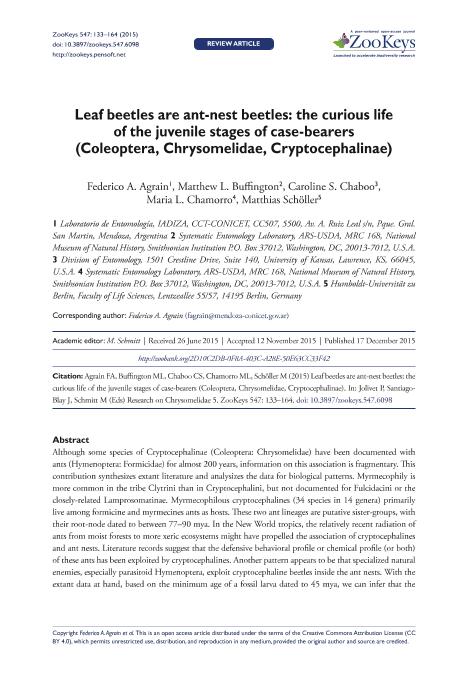Mostrar el registro sencillo del ítem
dc.contributor.author
Agrain, Federico Alejandro

dc.contributor.author
Buffington, Matthew L.
dc.contributor.author
Chaboo, Caroline S.
dc.contributor.author
Chamorro, Maria L.
dc.contributor.author
Schöller, Matthias
dc.date.available
2018-05-18T17:28:00Z
dc.date.issued
2015-12
dc.identifier.citation
Agrain, Federico Alejandro; Buffington, Matthew L.; Chaboo, Caroline S.; Chamorro, Maria L.; Schöller, Matthias; Leaf beetles are ant-nest beetles: the curious life of the juvenile stages of case-bearers (Coleoptera, Chrysomelidae, Cryptocephalinae); Pensoft Publishers; ZooKeys; 547; 12-2015; 133-164
dc.identifier.issn
1313-2989
dc.identifier.uri
http://hdl.handle.net/11336/45580
dc.description.abstract
Although some species of Cryptocephalinae (Coleoptera: Chrysomelidae) have been documented with ants (Hymenoptera: Formicidae) for almost 200 years, information on this association is fragmentary. This contribution synthesizes extant literature and analysizes the data for biological patterns. Myrmecophily is more common in the tribe Clytrini than in Cryptocephalini, but not documented for Fulcidacini or the closely-related Lamprosomatinae. Myrmecophilous cryptocephalines (34 species in 14 genera) primarily live among formicine and myrmecines ants as hosts. These two ant lineages are putative sister-groups, with their root-node dated to between 77–90 mya. In the New World tropics, the relatively recent radiation of ants from moist forests to more xeric ecosystems might have propelled the association of cryptocephalines and ant nests. Literature records suggest that the defensive behavioral profile or chemical profile (or both) of these ants has been exploited by cryptocephalines. Another pattern appears to be that specialized natural enemies, especially parasitoid Hymenoptera, exploit cryptocephaline beetles inside the ant nests. With the extant data at hand, based on the minimum age of a fossil larva dated to 45 mya, we can infer that the origin of cryptocephaline myrmecophily could have arisen within the Upper Cretaceous or later. It remains unknown how many times myrmecophily has appeared, or how old is the behavior. This uncertainty is compounded by incongruent hypotheses about the origins of Chrysomelidae and angiosperm-associated lineages of cryptocephalines. Living with ants offers multiple advantages that might have aided the colonization of xeric environments by some cryptocephaline species.
dc.format
application/pdf
dc.language.iso
eng
dc.publisher
Pensoft Publishers

dc.rights
info:eu-repo/semantics/openAccess
dc.rights.uri
https://creativecommons.org/licenses/by-nc-sa/2.5/ar/
dc.subject
Myrmecophily
dc.subject
Camptosomata
dc.subject
Larvae
dc.subject
Biology
dc.subject
Clytrini
dc.subject
Cryptocephalini
dc.subject.classification
Otras Ciencias Biológicas

dc.subject.classification
Ciencias Biológicas

dc.subject.classification
CIENCIAS NATURALES Y EXACTAS

dc.title
Leaf beetles are ant-nest beetles: the curious life of the juvenile stages of case-bearers (Coleoptera, Chrysomelidae, Cryptocephalinae)
dc.type
info:eu-repo/semantics/article
dc.type
info:ar-repo/semantics/artículo
dc.type
info:eu-repo/semantics/publishedVersion
dc.date.updated
2018-04-18T17:50:56Z
dc.identifier.eissn
1313-2970
dc.journal.volume
547
dc.journal.pagination
133-164
dc.journal.pais
Bulgaria

dc.journal.ciudad
Sofía
dc.description.fil
Fil: Agrain, Federico Alejandro. Consejo Nacional de Investigaciones Científicas y Técnicas. Centro Científico Tecnológico Conicet - Mendoza. Instituto Argentino de Investigaciones de las Zonas Áridas. Provincia de Mendoza. Instituto Argentino de Investigaciones de las Zonas Áridas. Universidad Nacional de Cuyo. Instituto Argentino de Investigaciones de las Zonas Áridas; Argentina
dc.description.fil
Fil: Buffington, Matthew L.. National Museum of Natural History; Estados Unidos
dc.description.fil
Fil: Chaboo, Caroline S.. University of Kansas; Estados Unidos
dc.description.fil
Fil: Chamorro, Maria L.. National Museum of Natural History; Estados Unidos
dc.description.fil
Fil: Schöller, Matthias. Humboldt-Universität zu Berlin; Alemania
dc.journal.title
ZooKeys

dc.relation.alternativeid
info:eu-repo/semantics/altIdentifier/url/http://zookeys.pensoft.net/articles.php?id=6098
dc.relation.alternativeid
info:eu-repo/semantics/altIdentifier/doi/http://dx.doi.org/10.3897/zookeys.547.6098
Archivos asociados
